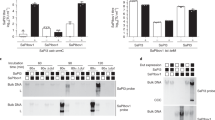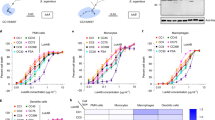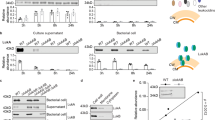Abstract
Toxic shock syndrome (TSS) is a complex of generalized symptoms caused by a local staphylococcal infection, and a circulating toxin is thought to be involved. Indeed, nearly 100% of TSS isolates produce an exoprotein, TSSE, that is thought to have an aetiological role on the basis of positive animal tests (refs 1,2 and F. Quimby, personal communication) and human serological data3. Although the precise role of TSSE in TSS remains unclear (E. Kass, personal communication), no other staphylococcal factor has been implicated. Our preliminary studies of the genetics of TSSE production failed to demonstrate plasmid or phage involvement or linkage with known chromosomal genes (ref. 4 and B.N.K. et al., unpublished data); however, Schutzer et al. have found that most TSS strains harbour prophages with common plating characteristics and suggest that the toxin(s) involved in TSS are transmitted by lysogenic conversion5. We show here that TSSE is not demonstrably transferred by lysogeny; moreover, we have cloned the gene and found that the cloned product is serologically and biologically indistinguishable from the native protein, and that the TSSE determinant is associated with a larger DNA segment that is absent or rearranged in TSSE− strains.
This is a preview of subscription content, access via your institution
Access options
Subscribe to this journal
Receive 51 print issues and online access
$199.00 per year
only $3.90 per issue
Buy this article
- Purchase on Springer Link
- Instant access to full article PDF
Prices may be subject to local taxes which are calculated during checkout
Similar content being viewed by others
References
Schlievert, P. M. J. infect. Dis. 147, 391–398 (1983).
de Azevedo, J. C., Hartigan, P. J., de Saxe, M. J., Bailey, C. J. & Arbuthnott, J. P. J. infect. Dis. (submitted).
Bergdoll, M. S., Crass, B. A., Reiser, R. F., Robbins, R. N. & Davis, J. P. Lancet i, 1017–1021 (1981).
Kreiswirth, B. N., Novick, R. P., Schlievert, P. M. & Bergdoll, M. S. Ann. intern. Med. 6(2), 974–977 (1982).
Schutzer, S. E., Fischetti, V. A. & Zabriskie, J. B. Science 220, 316–318 (1983).
Novick, R. Virology 33, 155–166 (1967).
Schafler, S., Francois, W. & Ruby, C. L. Antimicrob. A. Chemother. 9, 600–613 (1976).
Altemeier, W. A. et al. Ann. intern. Med. 6 (2), 978–981 (1982).
Mallonee, D. H., Glatz, B. A. & Pattee, P. A. Appl. envir. Microbiol. 43, 397–402 (1982).
Novick, R. P. et al. Proc. nat. Acad. Sci. U.S.A. 76, 400–404 (1979).
Thompson, N. E. & Pattee, P. A. J. Bact. 148, 294–300 (1981).
Elek, S. D. & Levy, E. J. Path. Bact. 62, 541–554 (1950).
Löfdahl, S., Guss, B., Uhlen, M., Philipson, L. & Lindberg, M. Proc. natn. Acad. Sci. U.S.A. 80, 697–701 (1983).
Meyer, F. T., Mlawer, N. & So, M. Cell 30, 45–52 (1982).
Tanaka, T. & Weisblum, B. J. Bact. 121, 354–362 (1975).
Robbins, R., Gould, S. & Bergdoll, M. Appl. Microbiol. 28, 946–950 (1974).
Schlievert, P. M., Shands, K. N., Dan, B. B., Schmidt, G. P. & Nishimura, R. D. J. infect. Dis. 143, 509–516 (1981).
Horinouchi, S. & Weisblum, B. J. Bact. 150, 804–814 (1982).
Southern, E. M. J. molec. Biol. 98, 503–517 (1975).
Guerry, P., LeBlanc, D. J. & Falkow, S. J. Bact. 116, 1064–1066 (1973).
Thuring, R. W. J., Sanders, J. P. M. & Borst, P. Analyt. Biochem. 66, 213–220.
Shafer, W. M. & Iandolo, J. J. Infect. Immun. 25, 902–911 (1979).
Pattee, P. A. & Neveln, D. S. J. Bact. 124, 201–211 (1975).
Maniatis, T., Jeffrey, A. & Kleid, D. G. Proc. natn. Acad. Sci. U.S.A. 72, 1184–1188 (1975).
Author information
Authors and Affiliations
Rights and permissions
About this article
Cite this article
Kreiswirth, B., Löfdahl, S., Betley, M. et al. The toxic shock syndrome exotoxin structural gene is not detectably transmitted by a prophage. Nature 305, 709–712 (1983). https://doi.org/10.1038/305709a0
Received:
Accepted:
Issue Date:
DOI: https://doi.org/10.1038/305709a0
This article is cited by
-
Lateral membrane organization as target of an antimicrobial peptidomimetic compound
Nature Communications (2023)
-
Bacterial cGAS senses a viral RNA to initiate immunity
Nature (2023)
-
The complex regulation of competence in Staphylococcus aureus under microaerobic conditions
Communications Biology (2023)
-
Synthetic antimicrobial peptides as enhancers of the bacteriolytic action of staphylococcal phage endolysins
Scientific Reports (2022)
-
Microscopy-based phenotypic profiling of infection by Staphylococcus aureus clinical isolates reveals intracellular lifestyle as a prevalent feature
Nature Communications (2022)
Comments
By submitting a comment you agree to abide by our Terms and Community Guidelines. If you find something abusive or that does not comply with our terms or guidelines please flag it as inappropriate.



